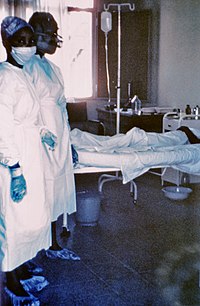
Photo from wikipedia
BackgroundSeries of biochemical and haematological changes occur during the course of dengue infection, which vary depending on the clinical disease. The patterns of change are not well documented and identifying… Click to show full abstract
BackgroundSeries of biochemical and haematological changes occur during the course of dengue infection, which vary depending on the clinical disease. The patterns of change are not well documented and identifying these patterns in children with dengue infection would help to anticipate the progression to different clinical stages thus enabling effective management.MethodsA prospective follow up study was conducted during the period of July 2013 – April 2014 at Professorial Pediatric unit, Lady Ridgeway Hospital for Children, Colombo, Sri Lanka. Children (5–12 years) admitted within the first 84 h of fever, with a clinical diagnosis of dengue infection were recruited. Children who became positive for dengue IgM were included in the final analysis. Blood was collected on admission for complete blood count, Alanine aminotransferase, Aspartate aminotransferase, albumin, cholesterol and corrected calcium. These tests were repeated at 12 hourly intervals during the hospital stay.ResultsData of 130-subjects were analyzed (Dengue fever /Dengue hemorrhagic fever: 100/30). There was a significant difference in the pattern of white cell counts, platelets and haematocrit in the two clinical groups. Both transaminase rose initially in both dengue fever and dengue hemorrhagic fever and a steep rise were seen between 8th and 9th days in hemorrhagic fever. Both albumin and cholesterol decreased significantly at the time of entering into the critical phase. According to Receiver operating characteristic curve analysis, albumin level crossing 37.5g/L (sensitivity 86.7%, specificity 77.8%) and a 0.38 mmol/L reduction in cholesterol level (sensitivity 77.3%, specificity 71.9%) between day 3 and 4 were the best predictors of entering into critical phase. Calcium levels did not show any distinct pattern.ConclusionsThere is a clear difference in the pattern of change of both hematological and biochemical parameters in dengue fever and dengue hemorrhagic fever. Reduction in albumin and cholesterol levels seen between the completion of day 3 and day 4 were highly valid predictors of entering into critical phase in dengue hemorrhagic fever.
Journal Title: BMC Pediatrics
Year Published: 2019
Link to full text (if available)
Share on Social Media: Sign Up to like & get
recommendations!